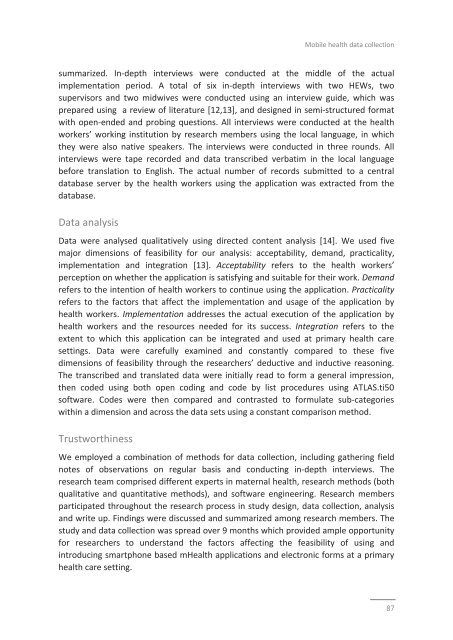araya-thesis
araya-thesis
araya-thesis
You also want an ePaper? Increase the reach of your titles
YUMPU automatically turns print PDFs into web optimized ePapers that Google loves.
Mobile health data collection<br />
summarized. In‐depth interviews were conducted at the middle of the actual<br />
implementation period. A total of six in‐depth interviews with two HEWs, two<br />
supervisors and two midwives were conducted using an interview guide, which was<br />
prepared using a review of literature [12,13], and designed in semi‐structured format<br />
with open‐ended and probing questions. All interviews were conducted at the health<br />
workers’ working institution by research members using the local language, in which<br />
they were also native speakers. The interviews were conducted in three rounds. All<br />
interviews were tape recorded and data transcribed verbatim in the local language<br />
before translation to English. The actual number of records submitted to a central<br />
database server by the health workers using the application was extracted from the<br />
database.<br />
Data analysis<br />
Data were analysed qualitatively using directed content analysis [14]. We used five<br />
major dimensions of feasibility for our analysis: acceptability, demand, practicality,<br />
implementation and integration [13]. Acceptability refers to the health workers’<br />
perception on whether the application is satisfying and suitable for their work. Demand<br />
refers to the intention of health workers to continue using the application. Practicality<br />
refers to the factors that affect the implementation and usage of the application by<br />
health workers. Implementation addresses the actual execution of the application by<br />
health workers and the resources needed for its success. Integration refers to the<br />
extent to which this application can be integrated and used at primary health care<br />
settings. Data were carefully examined and constantly compared to these five<br />
dimensions of feasibility through the researchers’ deductive and inductive reasoning.<br />
The transcribed and translated data were initially read to form a general impression,<br />
then coded using both open coding and code by list procedures using ATLAS.ti50<br />
software. Codes were then compared and contrasted to formulate sub‐categories<br />
within a dimension and across the data sets using a constant comparison method.<br />
Trustworthiness<br />
We employed a combination of methods for data collection, including gathering field<br />
notes of observations on regular basis and conducting in‐depth interviews. The<br />
research team comprised different experts in maternal health, research methods (both<br />
qualitative and quantitative methods), and software engineering. Research members<br />
participated throughout the research process in study design, data collection, analysis<br />
and write up. Findings were discussed and summarized among research members. The<br />
study and data collection was spread over 9 months which provided ample opportunity<br />
for researchers to understand the factors affecting the feasibility of using and<br />
introducing smartphone based mHealth applications and electronic forms at a primary<br />
health care setting.<br />
87


